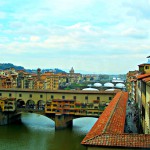- Shopping in Florence.
The first article – shopping in Florence:
No offence Dubai and Singapore, but there are cities where you might as well be blindfolded when you go shopping. You wake up in your hotel room and step out of the lobby into a kingdom of marble, air conditioning and identical-looking shops. It’s all very predictable and convenient for, say, a weary businessman who knows that there’s no way his special lady is going to turn down a Tiffany ring or a Gucci bag. It’s a failsafe option.
You can do exactly the same in Florence and hide yourself away in the airport duty free-style shops on the Via de’ Tornabuoni. But you can also go shopping for really unusual things in a city which is famous and interesting for all sorts of reasons. Above all, Florence is famous for its jewellery, leather goods and top quality paper. During the Renaissance something called a ‘bottega’ appeared. The word translates as ‘workshop’, although the English word isn’t an exact fit, as in workshops like these the master craftsman (the maestro) would create a masterpiece and his apprentices would then imitate it. So it’s very difficult to tell apart the original masterpiece and things that are copies of it, but by no means fakes. Everything has always been and always will be of the highest quality.
The realm of jewellery is to be found on the Ponte Vecchio. This bridge was originally built in 1177 and was then rebuilt in 1345. Ever since then there have been shops, boutiques and stalls on it. A point of interest is that this is where the word ‘bankrupt’ originates from. When traders couldn’t pay their rent soldiers would come along and break up their counter – or ‘banco’. That would ruin the counter – it would become ‘rotto’, which gives us ‘bancorotto’ and from which in turn we derive the English word ‘bankrupt’. Another point of interest is that originally all the traders on the bridge were butchers, until the Medici family (and you have to see their point) got fed up with having to look all the time at the blood pouring off it into the Arno and that was how jewellers came to take up residence there. When you’re walking across the bridge with your guy then you can tell straight away that men really did arrive on Earth from Mars and that we women are from Venus… A man’s eyes will glaze over, he’s got the frightened look of someone who knows he’s been cornered. Any woman who at that point was taken in for a dope test would come out positive, without a shade of a doubt. By the time you get to the middle of the bridge you’ll both have got your breath back and by that point it’s obvious that there is nowhere else where you can see so much beautiful jewellery, the work of true artists, anywhere else…
It’s said that we have the Medici family to thank for Michelangelo’s frescoes in the Sistine Chapel and for leather caskets made without a single stitch. Catherine de’ Medici brought her dowry and valuables with her in boxes and caskets such as these when she arrived in France to marry the future Henry II. Her future husband was so impressed by them that he ordered a number for himself. All the nobles of France followed suit and the lasting fame of the Florentine leatherworkers was assured.
In the 1930s the Scuola del Cuoio, the only school in Italy for training leatherworkers, was set up in the monastery of Santa Croce. Back then there were orphans who lived and were raised in the monastery and the school was supposed to teach them the trade and give them a start in life. But these days it’s a school for high-flying leatherworkers. You can call in and take a look at the students and masters at work. In the labyrinth of the numerous backstreets around the monastery you can pick up some of Florence’s leather wares – something traditional, in the line of what so impressed Henry II, or something up to the minute.
Marbled paper arrived in Florence in the 16th century. It was probably invented in China, then appeared in the Middle East in the 15th century and finally in Florence following the Battle of Lepanto. It attained widespread popularity in the city in the 18th century. Initially this paper was just used to decorate books and it was only later that it was used for printing. The ‘Il Papiro’ chain, which sells marbled paper, has achieved worldwide renown, but think twice before checking out any of their stores – in the historic centre you’ll find a huge number of tiny boutiques selling marbled goods which aren’t quite so high-end and without the corresponding price tag. You can’t finish your historical shopping spree until you’ve been to one of the oldest pharmacies in the world – Santa Maria Novella, founded by Dominican monks in 1221.
In a small garden in the courtyard behind the pharmacy the monks once grew herbs to make medicines, balms and ointments, mainly for the monastery’s own infirmary. In 1612 the ruler of Florence gave permission for the Dominicans to open a little chemist’s shop, whose fame spread throughout all of Europe. It may have had something to do with the fact that the formulas for many of the creams and balms was based on remedies invented especially for Catherine de’ Medici back in the 16th century.
The origin of eau de Cologne is also related to the history of this pharmacy. In fact the substance was originally Catherine’s own perfume, which she took with her to France before her marriage to the king. Originally that was what this perfume was called – ‘the queen’s aroma’. Then, in 1709 the Italian Giovanni Maria Farina took up residence in Cologne, rediscovered the recipe and began to mass-produce it. He named the perfume ‘eau de Cologne’ in honour of the city, forgetting that it was still being produced in his homeland under a completely different name as it had been for ages. And three centuries later we think we have problems legally protecting registered trademarks…
Once you’ve taken the two to three days that you need to explore the city’s history and do a bit of historical shopping I strongly recommend that you pay a visit to a very beautiful shop called PNP. There are two of them in Florence and the one on the Via del Proconsolo is the newer and the more handsome of the pair. It has an unusual looking interior with a glass floor through which you can look down at the medieval remains of what is either columns or something turned up in an archaeological dig. Their lines of clothing is equally unusual, so exclusive that they’re not to be found anywhere else in Italy, and the staff are really friendly, as are the successful owners. You can take a seat in the bar, relax after an overdose of history, take your other half off the leash and leave him in the trusty care of the salespersons. You won’t regret it.
Florence is the kind of place where embarking on a shopping trip means embarking on an excursion into its history. And PNP is no exception – make it your aim to find out what’s under the glass floor beneath you.


